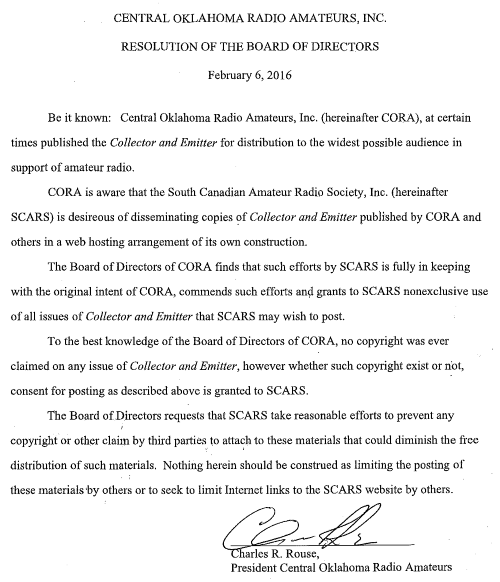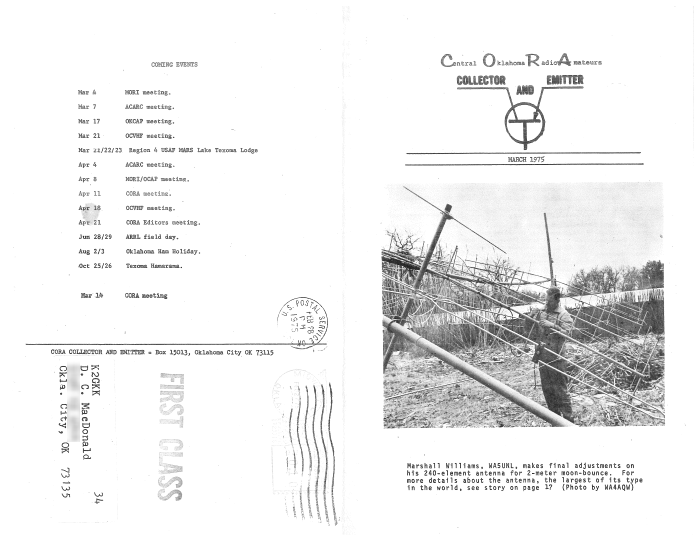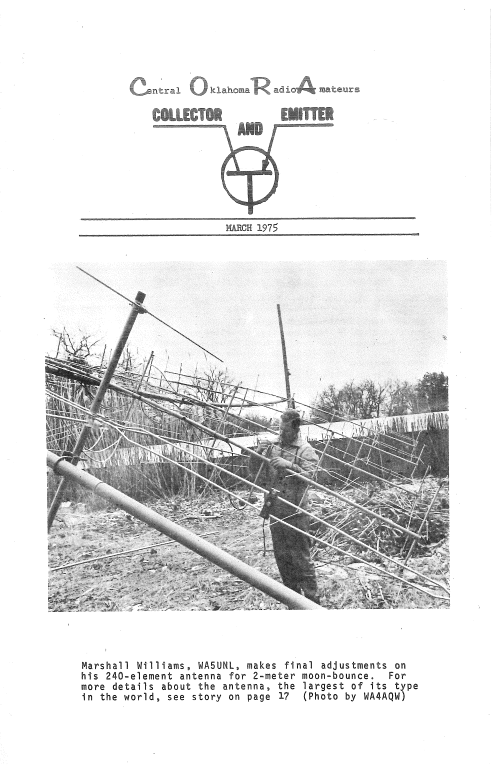

Central Oklahoma Radio Amateurs (CORA) was started to coordinate the activites of the growing number of Amateur Radio Clubs (ARCs) in the central Oklahoma area in the early 1970s. This coordinating body started with two main goals. The first was to produce an annual Amateur Radio conference in the Oklahoma City area. This event is called "Ham Holiday", and it has been held in the OKC area annually, since 1974. The second goal was to produce a combined monthly newsletter to allow the clubs in the area to communicate to their members in a more cost efficient manner. In the early days, a number of hams were members of multiple clubs, and this process reduced the through the duplication of efforts by all involved. Through the economies of scale, this newsletter would be centrally edited, printed, assembled, and mailed to all of the local hams that were club members.
This newsletter was given the name "The Collector and Emitter" (C&E), to continue the tradition of the Aereonautical Center Amateur Radio Club (ACARC) newsletter. A copy of the last ACARC issue, January 1975 discusses that this probably wasn't an easy change for the local hams to embrace. The last two years of the Mid-Oklahoma Repeator, Inc. newsletter are on file here. The last issue, January 1975, also talks about the new combined CORA Newsletter.
CORA produced this newsletter monthly from February 1975 until February 2002, with one exception, January 1976. When the publication finally faded, it appears that cost was the major impetus for change the in 2002. In the mid 1990's, this new-fangled thing called "The Internet" started to produce a number of different ways for ARCs to publish their own newsletters instantly, for free.
Unfortunately, these individual digital club newsletters have come, and gone, and not all of them have been able to keep archives of these digital formats. CORA still manages to communicate with all of their member clubs through monthly meetings. Here are the online web sites, and newsletters that we've been able to locate for amateur radio clubs in the central Oklahoma area.
The purpose of this project was to gather a copy of each C&E newsletter, scan them, and place them on the Internet for all to view. We're here to gather and display these old treasures.

On February 6, 2016, exactly 42 years after the first CORA C&E was distributed, the CORA board authorized president Charles R. "Dick" Rouse to create and sign a resolution that acknowledges this project, and ensures that these archived issues are made available for future review.
The newsletters for this project was initially gathered and classified by Gary Skaggs WB5ULK. He first was able to obtain a large collection of the Collector and Emitter's from Mac K2GKK and Judy KA5BJS MacDonald. He then ended up with another large collection from AE5MH Mark Hamblin. That collection included the issues from the long-time editor WA5ZNF Joe Harding. Over time, Gary worked with other local hams to fill in the missing slots. In the end, he ended up with three bankers boxes full of newsletters. Sorting through these boxes, he was able to select the best specimen available, and found that he had all but 6 issues when this site was launched.
The CORA C&E was produced in five different formats.

These newsletters were first scanned on a Ricoh 4501 Multi-Function-Printer, at 600 Dots Per Inch (DPI) for the first group of newsletters, at 300 DPI for the 11" x 15" format papers, and 200 DPI for the large 15" x 22" tabloid documents. This scanner produced a single PDF file for each of the original newsletters. Any mis-scans, jams, or skipped pages, were either rescanned, and edited into the PDF document, or simply rescanned in total. Each issue had two staples that were removed, and the newsletter was fanned out to smooth the path through the automatic document feeder. Most of the non-tabloid pages scanned through the feeder without any trouble. However, the tabloid issues had to be opened, laid on the flatbed scanner, and scanned manually. It sounds like a whole lot more work, however, these issues only took about twice as long as the smaller issues did. The first issues took about an hour each to scan, but the process smoothed out pretty quickly, and it averaged about an hour per year (12 issues) (about 30 hours) to get the documents scanned, and verified, and corrected. Each issue was then manually named as YYYY-MM.pdf, where YYYY was the year, and MM was the month of the issue.

Since these newsletters were produced and distibuted as booklets, scanning these pages produced pages that have two newsletter pages on each PDF page. Even worse, these scans were in signature form, with the last page of the issue, and the first page of the issue, on the first image of the PDF, as shown above. This format would not be convenient to read through a PDF reader, as the displayed PDF would be 'out-of-order'.
As a proof of concept, the first issue was manually split into individual Tagged Image File Format (TIFF) file pages. Each half of the TIFF image was copied, and pasted into new TIFF files, and then each cover had to be manually edited to remove the mailing label information to get rid of the personally identifiable informaiton (PII) of the newsletter donor. Finally, each of these files were renamed to include the year, month, and page number. These TIFF images then recombined into a single PDF for the month, and the process was completed. While the process worked well, and produced a useable PDF, this first issue took 16 hours to produce. At this rate, the 350 issues would take over 3 years of full-time effort.

To speed this process up, a couple of utilities from CoolUtils.com were used along with some custom code by Mark Kleine N5HZR, were used to perform all of those tasks, without any human involvement, in about 10 minutes per issue. Producing the page shown above.
The actual programmatic details are shown here...
The automated work flow made this project possible. While it took about 10 minutes of computer time to process each issue, this method dropped manual opertor time down to a few minutes per issue. Overall, this scanning/processing/programming phase took about 150 hours to complete, to process the 10,000 pages of newsletters.
Take a look at the MORI April 1974 issue, and you'll see that the very first Oklahoma City Ham Holiday was August 3rd and 4th, 1974. This first event was held at the Holiday Inn, in OKC. The event took part of its name from that location. Ham Holiday, get it?. In the MORI July 1974 issue, you'll see the first pre-registration form.
The following people have been instrumental to the success of this project. Thanks to all for their assistance.

Except where otherwise noted, content on this site is licensed
under a
Creative Commons Attribution-NonCommercial-ShareAlike 4.0 International license.
This page designed and processed by N5HZR. Feel free to send an email if you find something that needs attention.